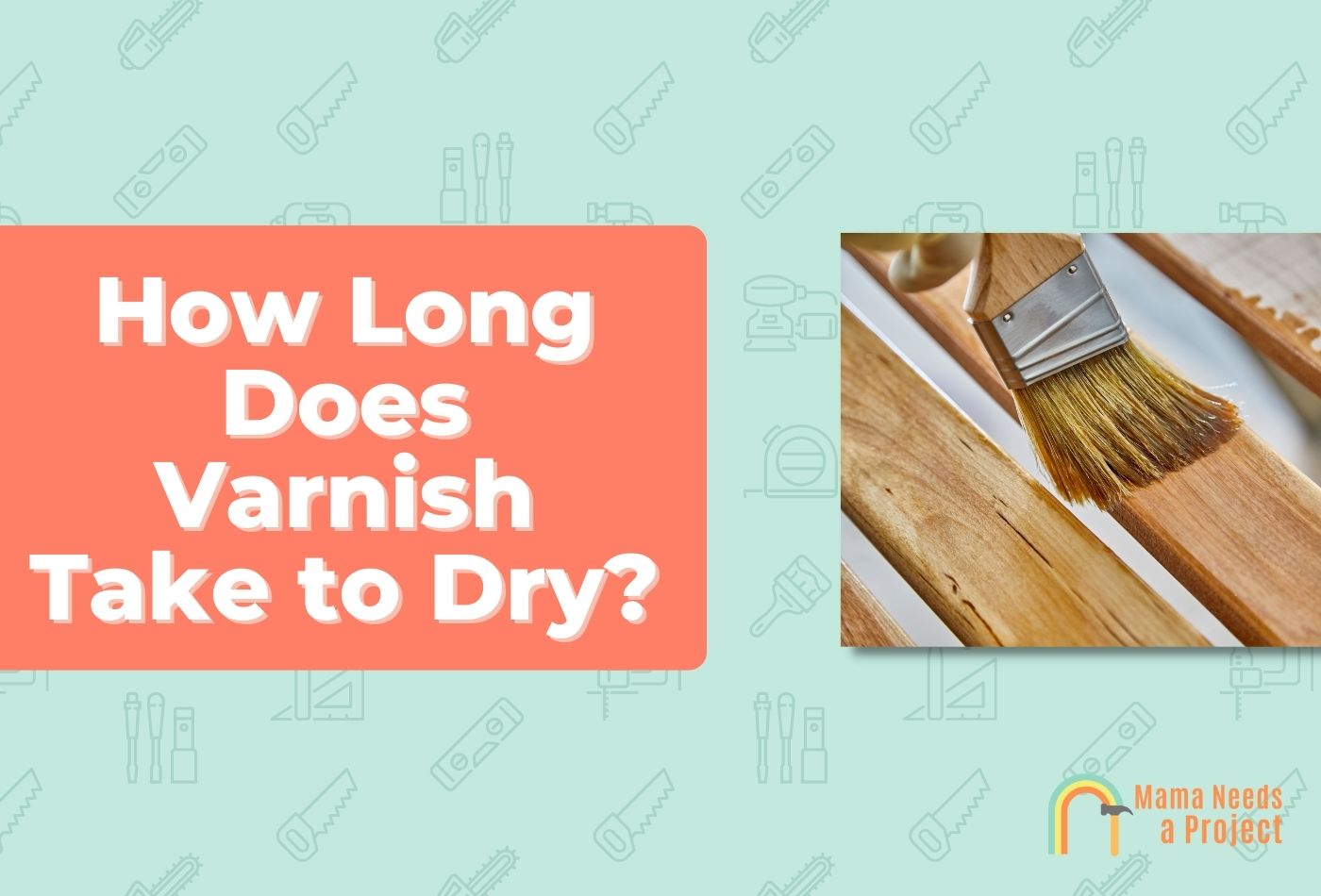How Long Does Varnish Take to Dry? (Fast Drying Tips!)
Varnish is a popular wood finish that’s used on everything from cabinets to furniture, as it accentuates wood grain and natural colors while providing superior protection for the wood.
But how long does varnish take to dry, and what factors influence varnish’s drying process? Let’s find out!
- Oil-based varnish takes 6-24 hours to dry, depending on which varnish you use. Water- and turpentine-based varnishes take 30-60 minutes to dry.
- How long it takes varnish to dry is largely determined by the amount of varnish applied, temperature and humidity, and other factors.
How Long Does Varnish Take to Dry?

Oil-Based Varnish
Oil-based varnish is basically a handful of resins, like amber and copal, dissolved in oil, that’s great for exposed surfaces that require frequent cleaning and polishing.
These varnishes are viscous and take longer to apply, but they’re more durable and often glossier than other varnishes.
Oil varnish works and looks best on non-porous woods with dense grains, like maple, cherry, and birch.
The most common oil-based varnish is oil-based polyurethane, but regular wood varnish—which is oil-based as well—also gets used often.
Oil based varnish takes anywhere from 8 to 24 hours to dry depending on several factors.
Water-Based Varnish
Unlike oil-based varnish, the primary solvent in water-based varnish is water.
These varnishes are made with acrylic resins, and since they’re much less viscous they dry quickly. Plus, applying water-based varnishes doesn’t take long at all.
And these varnishes are on the safer side too, since they contain less volatile organic compounds (VOC) than their oil-based counterparts.
They are, however, weaker than other varnishes, but all things considered they hold up pretty well if applied right and maintained well thereafter.
The most commonly used water-based varnish is water-based polyurethane.
Water based varnish takes anywhere from 1 to 2 hours to dry depending on several factors.
Check out these differences between oil based and water based polyurethane!
Spirit Varnish
Spirit varnish includes resins like shellac or lacquer dissolved in methylated spirit.
Often, a pigment is added so the varnish matches the color of the surface it’ll be applied to.
Spirit varnish dries quickly, but it’s weaker than other varnishes.
It’s used mostly on wood furniture that won’t be in harms way often, and it does require routine maintenance to keep its attractive appearance and soundness.
Spirit varnish takes anywhere from 30 minutes to 2 hours to dry depending on several factors.
Spar Varnish
Spar varnish is made of oils, solvents, resins, UV-protection additives, and drying agents, and this heavy-duty varnish is often used on boats, docks, and other marine structures, since it can withstand the sun, rain, wind, sea spray, and chemicals.
If applied right and maintained properly, spar varnish can remain sound and visually appealing for 7-10 years. After such time has passed, it’s best to strip the varnish and reapply.
Spar varnish takes anywhere from 4 to 6 hours to dry depending on several factors.
Bituminous Varnish
Bituminous varnish, otherwise known as black varnish, is basically bitumen (petroleum-based hydrocarbon) or coal that’s been dissolved in mineral spirits (paint thinner) or naphtha, and it’s usually applied to ironworks for corrosion protection.
It’s a very heavy-duty varnish, and because of its appearance it’s seldom used on wood or wood-based materials.
Bituminous varnish takes around 24 hours to dry depending on several factors.
Turpentine Varnish
When dammar gum, mastic, and other resins are dissolved in turpentine, the result is turpentine varnish.
This varnish has a distinct light color, and it also dries relatively quickly.
But turpentine varnish isn’t as durable as other varnishes, which is why it’s mainly used to accentuate wood surfaces that won’t be in harm’s way.
And because of its components, this is one of the more toxic varnishes. Therefore, since it emits fumes and causes irritation of the eyes, nose, throat, and skin, it’s best to wear all necessary safety gear, i.e. goggles, a respirator, gloves, long-sleeves and pants, when applying this varnish.
Turpentine varnish takes anywhere from 30 minutes to 1 hour to dry depending on several factors.
Alkyd Varnish
One of the most versatile varnishes, alkyd varnish can be used both indoors and outdoors.
It’s called “alkyd varnish” because it’s made with alkyd resins, i.e. polyester resins that have been modified by the fatty acids found in vegetable oil.
In addition to being quick-drying and visually appealing, this varnish also ensures solid UV protection and overall durability that’s hard to match.
And since it’s a clear varnish, it can be used on both softwoods and hardwoods.
Alkyd varnish takes around 6 to 8 hours to dry depending on several factors.
Asphalt Varnish
Asphalt varnish is created by dissolving melted asphalt in linseed oil. And sometimes turpentine or petroleum spirit is added to make this varnish less viscous.
Like bituminous varnish, this finish is mainly used on ironworks and steel, and it’s best to avoid using it on wood and wood-based products.
Asphalt varnish takes around 24 hours to dry depending on several factors.
What Affects the Drying Time of Varnish
The main factors that determine the varnish dry time include:
- Thickness of coats
- Porousness of the workpiece
- Temperature
- Humidity
- Airflow
How to Tell if Varnish is Completely Dried
No Smell
Unless you’re using water-based varnish, which doesn’t emit a distinct smell, you can use the “smell test” as a way to tell whether or not the varnish has dried completely.
Basically, if the surface that received varnish no longer smells, this is a good indication that the drying process is complete.
Still, it’s best to confirm with another test, like the “touch test”, before you start treating the varnish like its totally dry.
After all, if you start to work on the varnish before it’s had a chance to dry completely, a big mess could be on your hands and you’ll probably have to reapply the varnish, elongating the overall process.
No Longer Tacky
When a varnish coat is semi-dry, it’ll feel tacky.
That said, a varnish coat could feel tacky even after it’s completely dry, indicating too much varnish was applied—this happens more with oil-based varnishes than it does with water-based versions.
But just because the surface feels tacky doesn’t mean there’s a problem—just give it more time to dry. If after several hours it’s still feeling tacky, you may need to strip the varnish and reapply.
Lastly, if you apply varnish in a space where there’s high moisture content in the air, it’s likely the varnish will stay tacky for longer. Keep this in mind before you apply varnish.
No Longer Shiny

If the surface still looks extra shiny, this is probably because the varnish hasn’t had a chance to dry completely yet.
That said, many varnishes are naturally glossy, so you can’t mistake a varnish’s natural look for a wet surface.
This is why it’s best to do at least two dryness tests before determining that varnish is dry or not. Even flat varnish, which isn’t that shiny when dry, is shiny when first applied.
Of course, if you’re using a high-gloss varnish, this test probably won’t do you much good, since it’ll be hard to distinguish wetness from the varnish’s natural luster. Therefore, you’ll have to do the smell or touch test to confirm.
Note: Just be careful when doing the smell test on a high-gloss varnish, as these usually emit harsh fumes that can cause lightheadedness, headaches, etc.
How Long Does Varnish Take to Cure?
The curing process is different from the drying process, but I’ll get into that more later on.
Oil-based varnishes can take as many as 30 days to cure completely, and there’s not much you can do to speed up this cure time. Water-based varnishes, on the other hand, take just two weeks to cure completely.
The time it takes varnish to cure is for the most part determined by the same factors that determine drying speed, but the curing process can’t be expedited like the drying process.
For this reason, you should only apply varnish when you know it’ll have the time needed to fully cure undisturbed.
Varnish Drying vs Curing
When a varnish is “dry”, this essentially means the liquid components have evaporated and the varnish is no longer wet. You can work with freshly applied varnish when it’s in this condition.
Fully cured varnish, on the other hand, is varnish that’s had a chance to totally solidify. Only when varnish is 100% cured can it provide the protection it’s known for.
Check out this guide to learn how long it takes for polycrylic to dry!
How to Speed Up the Drying Time of Varnish
Apply Thin Coats
When applying varnish, it’s best to apply thin layers, especially if you’re using an oil-based polyurethane varnish.
A thin coat of varnish will dry quickly and properly. A thick coat of varnish, on the other hand, will take much longer to dry and possibly not dry all the way through, which will cause problems later.
To ensure you only apply thin coats, use a cloth as an applicator (as opposed to a paint brush or foam roller).
Yes, it’ll take longer to apply the varnish this way, but it’s the best way to achieve a thin, smooth coat that can accommodate multiple layers on top.
Use Heat
You can use a heat gun or hair dryer to speed up the drying process, but you should really only do this if you absolutely need the surface to be dry as soon as possible.
It’s easy to mess up the surface heating it up this way, and you certainly don’t want to ruin the finish in an effort to speed up drying.
You could also set the workpiece out in the sun to dry quicker, but only do this with a varnish that can handle direct sunlight exposure, i.e. alkyd varnish.
Increase Airflow
There should be decent airflow in the room where you’re applying varnish. If this is absent, it’ll take longer for the varnish to dry. It’s also safer to work in a well-ventilated area.
Turn on a ceiling or floor fan to increase air circulation. Just make sure the fans aren’t spinning too fast, as this could kick up dust and dirt that, if it lands on the varnish, can negatively affect it as it dries.
How Porousness Affects Drying Time
Some woods are more porous than others, and those that are more porous take longer to dry because the varnish has to be absorbed before it can dry.
Less porous surfaces, like hardwoods, promote faster drying because the varnish doesn’t really seep in before drying.
Final Thoughts
To recap, different varnishes have different drying times, with water-based and turpentine being the fastest (30 min) and bituminous and asphalt taking the longest (24 hours).
Additionally, the drying process for any varnish is in large part determined by:
- Thickness of coats
- Porousness of the workpiece
- Temperature
- Humidity
- Airflow

